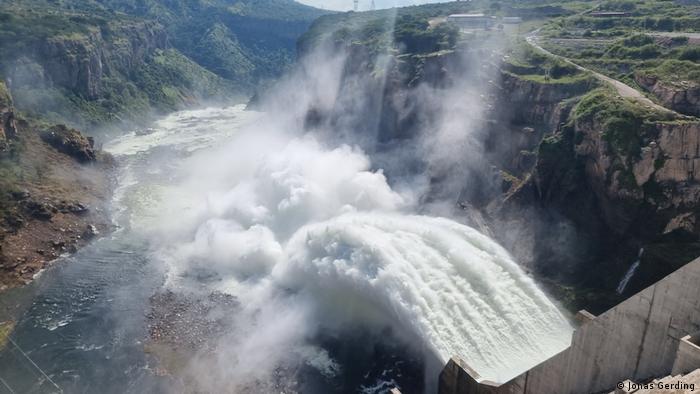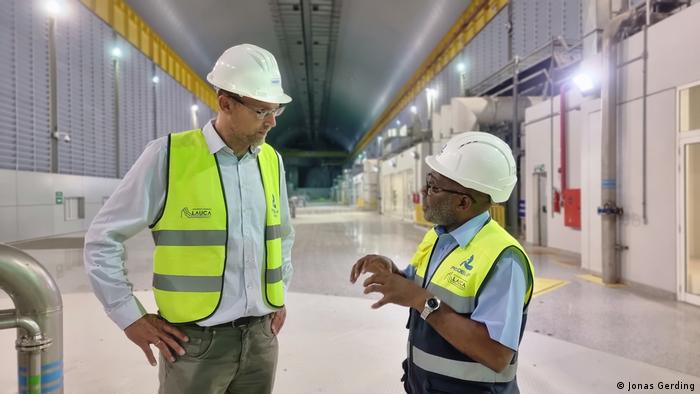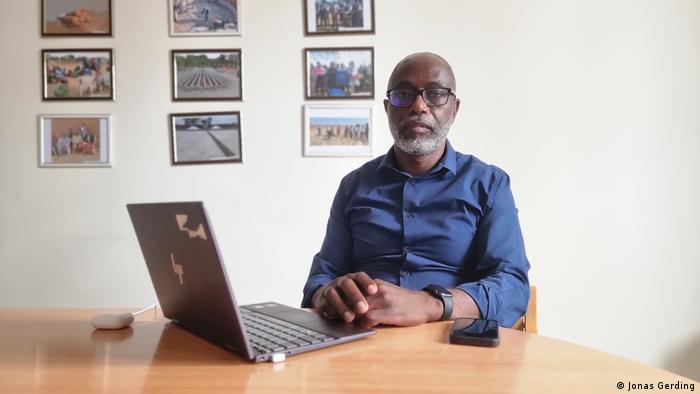German project developers want to use an existing power plant in Angola to produce hydrogen for Europe's industries. At the same time, many private households in Angola have no electricity. How does that go together?

The water falls 156 meters at the Laúca dam – but the full capacity is not used
Lars Schneider walks along the edge of the dam. 156 meters it goes down next to him. The recent rainfall has been so plentiful that part of the water from the Cuanza River is being drained and sprayed down the valley as a huge fountain at the foot of the dam. “It makes an engineer's heart beat faster,” says Schneider, tall and wearing a safety helmet. For the Nuremberg project development company Gauff, he visits the Laúca dam, about four hours by car south-east of the Angolan capital Luanda. Completely different dimensions than in Europe they are, says the 50-year-old. “When you work there, you can really feel what you ultimately planned.”
Gauff and the Hamburg-based consulting company Conjuncta have teamed up with Sonangol, Angola's state-owned energy company. They want to convert part of the energy that is produced here into hydrogen – and export it to Germany. The project, which could deliver green hydrogen as early as 2025, is estimated to cost around one billion euros. Because wind turbines and photovoltaics alone will not be enough to cover the great need of German industry for sustainable energy.
Angola as a test run for Germany
Gauff has been in Angola for more than 20 years and has set up numerous infrastructure projects. The company's project teams know the country and its rivers, which meander through deep gorges like the Cuanza. Ideal to stow them away. “So we thought about examining the possibilities here in Angola more closely,” says Schneider. They found what they were looking for at the relatively young hydroelectric power station in Laúca.
The project in Angola is an important test run for Germany. The Federal Foreign Office is currently opening hydrogen offices in a hurry in countries such as Nigeria and Saudi Arabia. Private-sector projects are being planned in Namibia and Morocco. In Angola, however, Schneider and his team have an advantage: the energy is already available. Hydrogen production could start earlier than elsewhere.
Low demand due to lack of industry
Underground pipes lead the water from the dam to the hydroelectric power station two kilometers away. The operators blasted a huge hall into the rock for this purpose. Here the masses of water encounter four humming turbines. But: Two more are not in use.
Moisés Jaime leads to a neighboring building. The director of the Laúca power plant is wearing a blue, short-sleeved shirt over which he has thrown a work vest with all sorts of pockets. He looks at a wall of monitors that show what the turbines are producing. Overall, the current capacity is 856.9 megawatts. They could be ramped up to 2070 megawatts.

“The machines would be happy,” says dam director Moisés Jaime (right) when meeting Gauff engineer Lars Schneider
But there is a lack of demand, says the director. Angola's energy strategy also shows that more growth was expected from industry. And so this and other ambitious hydropower projects along the Cuanza River are now without a sufficient number of commercial buyers. Gauff would therefore like to convert 400 megawatts into hydrogen with his partners – enough to supply around 450,000 German households with electricity.
“This is a good initiative that we welcome,” says power plant director Jaime about the hydrogen production project for Germany. “Above all, the machines will be happy because they can push their limits and produce at full capacity. Without industry, we can do absolutely nothing here.”
This could open up a new market for Angola's economy. Oil and gas have so far covered 85 percent of the country's export earnings. Hydrogen represents a promising source of income.
No electricity for Angola's population
Sérgio Calundungo is the coordinator of the Observatory for Political and Social Affairs in Angola with an office in the capital. His beard is mottled gray and his hair is thinning. Calundungo, who has overseen rural development projects for many years, expresses concerns about green energy exports. Because only 42 percent of the people in Angola have access to electricity. Some places are not online at all.

Sérgio Calundungo is concerned about the population's electricity connection
He does not accept the argument that there are no buyers for the electricity from the power plants. “It's not due to a lack of demand,” he says firmly. It is true that private households can sometimes contribute less money than industrial companies. “There are economic hurdles when it comes to accessing electricity – there's a lack of money,” he says. But that alone doesn't explain the problem. “There are also technological hurdles. The country is not investing in the necessary technologies and in distribution.”
And yet: Basically, the country has such enormous energy resources that in future foreign countries can also be supplied with hydrogen, he says. It just has to go hand in hand with improving the energy supply for our own population: “I think we have to do both at the same time.”
Green hydrogen by ship
A little further north, Lars Schneider stands on the side of the road outside of Luanda, gazing at cranes working on a new port a few hundred meters away. In addition, Gauff wants to pull up the hydrogen factory. The location is perfect: around 210 kilometers of high-voltage lines run from the Laúca power plant directly to a nearby substation. A river provides water to produce the hydrogen in the electrolysis process.

A long power line connects the hydroelectric power plant with the site of ammonia production near the coast
They want the hydrogen first converted into liquid ammonia, with which the cargo ships are filled. “Ammonia can be liquefied at relatively mild temperatures of minus 33 degrees,” says Schneider, making a comparison with pure hydrogen, which requires minus 253 degrees. “It's almost fluffy and warm there.”
Arriving in Germany, the ammonia has to be converted back into hydrogen. After all, power plants use it to produce the electricity for the energy centers.
Sounds complicated. But the project developers from Gauff and their partners in Angola want to explore whether that might even solve Angola's electricity problem, says Schneider. “The biggest wish is, of course, that sustainable energies are also used to develop remote areas. Hydrogen can be used wonderfully for that.”